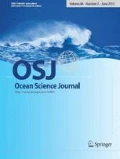Abstract
Aurelia coerulea is a bloom forming jellyfish that first appeared before 1980 in the western and southern Korean seas and which has been blamed for huge economical losses in all fields of marine activities. As a preventive measure to reduce economical losses, polyp removal was undertaken at Lake Shihwa, Lake Saemangeum, and Masan Bay, Korea. In the course of efforts during 2 years to remove polyps, polyps were surveyed, quantified, and removed. In these areas, the initial total polyp abundance was 5.04 × 109 and 46.25% of them were removed; Lake Shihwa the highest rates of removal and Lake Saemangeum the lowest. These efforts to remove polyps prevented the appearance of 1.20 × 109 medusae, corresponding to 78.28 × 106 kg. The cost of polyp removal was evaluated and compared with that of medusae removal. The ratio between the cost of polyp removal and that of medusae removal ranged between 0.78–3.14%, indicating large cost savings for polyp removal undertakings. However, the effect of polyp removal varied from positive to none, and we assumed that the cleared surface for polyp removal, quantity of removed polyp, and existence of polyps’ hotspots in neighboring areas were the causes of the non-effectiveness of polyp removal undertakings.
Similar content being viewed by others
References
Choi CH, Jung SW, Yun SM, Kim SH, Park JG (2013) Changes in phytoplankton communities and environmental factors in Saemangeum Artificial Lake, South Korea between 2006 and 2009. Korean J Environ Biol 31(3):213–224
Choi K, Kim SW, Kim DS, Heo W, Lee Y, Hwang IS, Lee HJ (2008) Eutrophication in the upper regions of brackish lake Shihwa with a limited water exchange. Korean J Limnol 41(2):216–227 (in Korean)
Han MW, Park YC (1999) The development of anoxia in the artificial Lake Shihwa, Korea as a consequence of intertidal reclamation. Mar Pollut Bull 38(12):1194–1199
Jeong YH, Yang JS (2015) The long-term variations of water qualities in the Saemangeum salt-water lake after the sea-dike construction. J Korean Soc Mar Environ Energy 18(2):51–63
Kang NS, Lee KH, Jeong HJ, Yoo YD, Seong KA, Potvin É, Hwang YJ, Yoon EY (2013) Red tides in Shiwha Bay, western Korea: a huge dike and tidal power plant established in a semi-enclosed embayment system. Harmful Algae 30:S114–S130
Kim DH, Seo JN, Yoon WD, Suh YS (2012) Estimating the economic damage caused by jellyfish to fisheries in Korea. Fisheries Sci 78:1147–1152
Kim K, Kahng S, Lee H, Lee K, Han M (2012) The story of Lake Shihwa. Ministry of Land, Transport and Maritime Affairs, 24 p
KIMST (2015) Management of marine organisms causing ecological disturbance and harmful effects. Chap. 4. Jellyfish. Korea Institute of Marine Science and Technology Promotion, 78 p (in Korean)
KOEM (2015) Marine habitat function improvement and restoration: 2015’s jellyfish polyp removal and monitoring. Korea Marine Environment Management Corporation, 83 p (in Korean)
Lee CH, Lee BY, Chang WK, Hong S, Song SJ, Park J, Kwon BO, Khim JS (2014) Environmental and ecological effects of Lake Shihwa reclamation project in South Korea: a review. Ocean Coast Manage 102:545–558
Lie HJ, Cho CH, Lee S, Kim ES, Koo BJ, Noh JH (2008) Changes in marine environment by a large coastal development of the Saemangeum reclamation project in Korea. Ocean Polar Res 30(4):475–484
Lim DI, Jung HS, Kim KT, Shin HH, Jung SW (2012) Sedimentary records of metal contamination and eutrophication in Jinhae-Masan Bay, Korea. Mar Pollut Bull 64:2542–2548
Lim HS, Diaz RJ, Hong JS, Schaffner LC (2006) Hypoxia and benthic community recovery in Korean coastal waters. Mar Pollut Bull 52:1517–1526
MLTM (2009) Planning research on preventing damages from the jellyfish. Ministry of Land, Transport and Maritime Affairs, 225 p (in Korean)
NIFS (2008) Mass occurrence of jellyfish and its prevention and utilization. National Institute of Fisheries Science, 183 p (in Korean)
NIFS (2009) Hypoxia in the coast of Korea. National Institute of Fisheries Science, GMK Communication, Busan, 173 p (in Korean)
NIFS (2013) Jellyfish studies in Korea. National Institute of Fisheries Science, 186 p (in Korean)
Palomares MLD, Pauly D (2009) The growth of jellyfishes. Hydrobiologia 616:11–21
Park JK, Kim ES, Cho SR, Kim KT, Park YC (2003) Annual variation of water quality in the Shihwa Lake. Ocean Polar Res 25(4):459–468
Schiariti A, Melica V, Kogovšek T, Malej A (2015) Densitydependent effects control the reproductive strategy and population growth of Aurelia aurita s.l. scyphistomae. Mar Biol 162:1665–1672
Scorrano S, Aglieri G, Boero F, Dawson MN, Piraino S (2016) Unmasking Aurelia species in the Mediterranean Sea: an integrative morphometric and molecular approach. Zool J Linn Soc-Lond 180(2):243–267
Shin JK, Kim DS, Cho KJ (2000) Dynamics of inorganic nutrients and phytoplankton in Shihwa Reservoir. Korean J Limnol 33(2):109–118
Uye SI (2008) Blooms of the giant jellyfish Nemopilema nomurai: a threat to the fisheries sustainability of the East Asian Marginal Seas. Plank Benth Res 3(Suppl):125–131
Yoo YD, Jeong HJ, Kim JS, Kim TH, Kim JH, Seong KA, Lee SH, Kang NS, Park JW, Park J, Yoon EY, Yih WH (2013) Red tides in Masan Bay, Korea in 2004–2005: II. Daily variations in the abundance of heterotrophic protists and their grazing impact on red-tide organisms. Harmful Algae 30:S89–S101
Yoon WD, Lee HE, Han C, Chang SJ, Lee K (2014) Abundance and distribution of Nemopilema nomurai (Scyphozoa, Rhizostomeae) in Korean waters in 20052013. Ocean Sci J 49(3):183–192
Author information
Authors and Affiliations
Corresponding author
Rights and permissions
About this article
Cite this article
Yoon, W., Chae, J., Koh, BS. et al. Polyp Removal of a Bloom Forming Jellyfish, Aurelia coerulea, in Korean Waters and Its Value Evaluation. Ocean Sci. J. 53, 499–507 (2018). https://doi.org/10.1007/s12601-018-0015-1
Received:
Revised:
Accepted:
Published:
Issue Date:
DOI: https://doi.org/10.1007/s12601-018-0015-1




